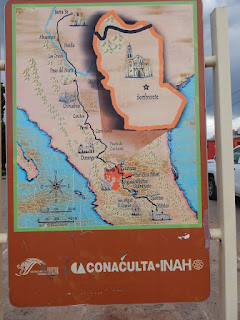What are “Pueblos Mágicos”?
While traveling and writing my first book, Painting Mexico: Magical Towns in Guanajuato, I came across references to “Pueblos Mágicos”, as three of the towns that I selected for my book happened to be one. These pueblos are San Miguel de Allende, Dolores Hidalgo and Mineral de Pozos. The forth town in my book, the City of Guanajuato, is not a Pueblo Mágico, but rather an UNESCO World Heritage Site a Patrimonio Mundial, a higher (world) designation and status. Unknowingly, my selection of these scenic towns was spot on, as I quickly recognized their scenic, architectural and cultural beauty-and charm. With my background in environmental design, landscape architecture and art, along with extensive travel experience, I recognized an impressive program and organization: Mexico’s Pueblos Mágicos. These pueblos were ideal for landscape artists, photographers and architects to explore, document-and honor-with their talents.
 |
| San Miguel de Allende, Guanajuato |
Intrigued with the idea of recognized “magical towns”, I did some research on the organization and found that Mexico’s Pueblos Mágicos was establish as a program n the millennial new year of 2001 by the country’s Ministry of Tourism for the purpose of promoting tourism and development in outstanding towns located in all 31 states throughout the country. Pueblos Mágicos, as the program is officially called, worked with state offices of tourism to identify towns that could possibly serve as “magical” towns, and be included in this program.
 |
| Sombrerete, Zacatecas |
Pueblos Mágicos developed specific criteria for selecting towns and a definitive process for their selection, involving committees at the federal, state and municipal level, all working systematically together to identify and invite deserving towns. (Pueblos Mágicos are legal jurisdictions classified as “municipios”; a municipiois the equivalent of a US county seat). By nine years 32 towns were selected for inclusion in this program. Then determined successful, the program continued and now includes 121 official Pueblos Mágicos (2019).
 |
| Pátzcuaro, Michoacán |
The selection criteria are rigorous, and include not only the “magical” aspects of the town (culture, scenic qualities, historic significance; foods, festivals, noted handicrafts and arts, etc.); but also the location (no more than 300 kilometers from a major urban area), adequate health care (small hospital or sophisticated clinic); security; adequate lodging and restaurants. Pueblos Mágicos are also required to have a dependable tourism office (Oficina de Turismo) and a museum (Museo or Casa de la Cultura) to assist and inform visitors during their stay.
 |
| Dolores Hidalgo, Guanajuato |
Once accepted as a Pueblo Mágico, the federal and state government would assist the town in accommodating tourism by granting monies for restoration of plazas and parks, streets, infrastructure improvements; promotion and marketing, cultural programs, etc. Thus, a town’s selection leads to growth, jobs and economic stimulus to these enchanting places, many in remote, off-the-beaten-path locations. Obviously, a side benefit is the diversification of Mexico’s tourism industry that benefits all citizens, urban and rural, something that is needed in this large, diverse developing country.
 |
| Jalpan de Serra, Querétaro Pueblo Mágico |
For my intended writing and art projects, the Pueblo Mágico program was a godsend: I would no longer need to visit towns, one-by-one, to find those suited for my writings. (This saved much time and money!) Rather, I could use these selected towns confidently, knowing they are special and can safely accommodate the needs of visual and cultural tourism. (I will also use non-Pueblos Mágicos in my writings if I believe that they are capableof becoming a “magical town”).
 |
| Mineraal de Pozos, Guanajuato |
To-date (2019), the 121 official Pueblos Mágicos represent nearly every region, state and major ethnic group in Mexico. The last group of ten new towns that were selected was from over 80 applications. This shows the stiff competition among many exceptional towns to be included in this exciting program.
The towns are as diverse and different as their number suggest, from a sophisticated, ex-Mágico like San Miguel de Allende (San Miguel became a Patrimonial Mundial), to small, rural “mágicos” like Pinos and Real de Asientos in the rolling mountains to the north. Each town is unique and literally one-of-a-kind. Many have fairytale settings and deserve to be in books, paintings and photo albums.
 |
| Pinos Pueblo Mágico, Zacatecas |
I have visited about 40 of these enchanting towns and have selected a little more than half of them to be included in my future books and projects. The Pueblo Mágicos that I have visited are primarily located in ten states in central and northern Mexico. (I purposely traveled to all these towns by bus and public transportation to fully understand their context and accessibility. I’ll comment on traveling by public transportation in a later posting).
 |
| Real de Asientos, Aguascalientes |
The Pueblos Mágicos program has two main sources of information: its website, http/ www.pueblosmagicos.mx.com; and an informative, photograph-adorned book published about every two years that you can find in most of the pueblos’ Oficina de Turismo.
Wikipedia also has an article (in English): https://en.wikipedia.org/wiki/Pueblo_Mágico-that covers the foundation and development of the program.
I’ve posted several dozen photo albums from the Pueblos Mágicos on my Facebook page under “Jack Hannula”, (Painting in Mexico’s Pueblos Mágicos page).
Edited 3-12-2019





No comments:
Post a Comment